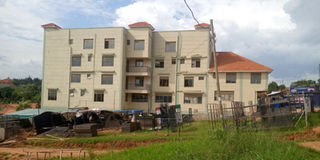Mulawa is a residential haven

One of the newly completed apartment blocks in Mulawa. Photos by Roland D. Nasasira.
What you need to know:
- Public facilities. The trend and standard of development in any area normally determines and attracts public facilities such as schools in the same measure. Some of the schools that have been built up in the area to match the increasing development include Sapphire Urban School and Shimoni Demonstration School, formerly located within Kampala City centre that has since found a new home in Mulawa.
Mulawa found in Kira Parish in Kira Sub-County, Wakiso District, is a hilly village with breathtaking valleys. Its residents have taken advantage of its terrain to construct splendid homes on its various hills.
Mulawa is approximately two kilometres from Kira main Trading Centre at the roundabout that leads to Kasangati, Kyaliwajjala and Kiwatule, and approximately 15 kilometres from Kampala City centre via Kiwatule.
Like most places, Mulawa has two faces. Mulawa Trading Centre mostly comprises of tall commercial buildings of between two to four floors and quite a number of those that are non-storeyed, characterised with a beehive of activity, from retail shops to food stalls and boutiques.
A walkable distance away from the centre is where you will find the other face of Mulawa with magnificent homes with different architectural designs. These lie adjacent to the many access roads named after personalities and a number of empty plots, with some currently occupied by small banana plantations. It is an averagely built up area that still maintains its nature in form of trees.
Standard of homes
Most of the homes in the area are roofed with tiles, save for a scattered few that have versatile iron sheets.
Much as there is a great deal of already complete and occupied homes, there are equally those that are still under construction as well as a number of fenced-off empty plots with their development foundations still at initial stages.
Also, while many of the homes are surrounded by perimeter walls, there are also a number that are still in the open, with no perimeter walls.
Allan Ssempungu, a resident, says the kind of building one builds sets precedence and trend for others. Asked why most of the houses in the area are roofed with tiles, Ssempungu says “Mulawa is home to rich businessmen and a number of politicians. This class of people prefer tiled houses to those with corrugated iron sheets.”
Cost of rent
Generally, Ssempungu opines that the cost of rent in the area is somewhat cheap and affordable because of its distance from the city centre. Renting a two bedroom, self-contained house with a living room in a perimeter wall costs between Shs400,000 to Shs500,000. He adds that in most cases, the number of bedrooms a house has determines the cost of rent.
According to 70-year old Yusuf Kityo, a native of the area, the cost of land at Mulawa has grown at a steady pace over the years, partly because of the increase in the number of people buying land for permanent residence.
This, to Kityo, explains why it is not only hard to find a local or resident putting up their house for sale but also the increasing cost and value of land.
However, in an event that you are searching for a house to buy in Mulawa, Kityo says one with at least two bedrooms, a living and dining rooms costs approximately Shs100m while a family house of three or four bedrooms costs about Shs250m and above regardless of its location.
“If a house is on sale, what in most cases determines its cost is the material (tiles or versatile iron sheets) that was used for roofing and the number of bedrooms it has. The more bedrooms it has, the higher the price tag it will command from the seller,” Kityo explains.
Cost of land
Kityo reveals that recently, there was an acre (100x100 feet) of land along the main road within Mulawa whose owner put up for sale at Shs200m which failed to get a buyer. This, to Kityo, means the location factor also determines the cost of land.
On the other hand, he shares that a 50x100 feet (half an acre) of land in the same area costs between Shs55m to Shs65m.

More residential houses are still under construction in the area.
“What you need to beware of are the brokers in the area. They sometimes push up the cost of land because they want to make profit from the land owner when the land is eventually sold off.
Before you seal the deal, make personal research to establish the actual price the owner is selling their land at,” Kityo advises.
The current and future residential development at Mulawa is one of the signs that more urban dwellers prefer quiet places to noisy Kampala suburbs. It is just a matter of time before it is entirely built up.




